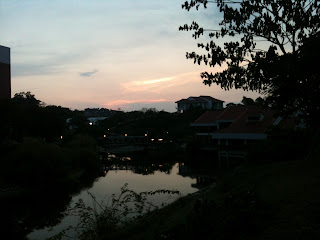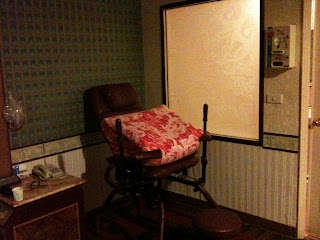The
University
I am now in
the University – Tainan National University of the Arts to provide its full
title. The University is sited in
the countryside, which is both wonderful in terms of focus and peace, and a
little bit of a problem, as any desire to buy something or explore the city of
Tainan involves a journey by bus and then by train. But transport is cheap, efficient, and the landscape around
the University contains many surprises.
Of these more in the future, but first the University.
The University at dusk
There is a
lake in the centre of the University grounds, and this becomes a canal between
the houses provided for the Visiting Professors. Over this are a series of bridges, the one nearest to my
accommodation fairly unremarkable, but there are also three stone bridges. These are rather beautiful, and they
date back to between the 13th and 16th century. Crossing over one of these bridges is
to be transported from the contemporary surroundings of the University housing to
an unspecified time past, and the marks of many feet over the years, together
with the designs still visible carved into the stones, connect you to the users
and makers of these structures.
They exert a fascination, and even though they are dislocated from their
original contexts, for each came from a different place, this in no way
diminishes their impact.
Surrounded by the architecture of the University they stand out, but if
this is because of some intrinsic quality of their craftsmanship or merely a
result of their age I cannot ascertain.
The three old bridges
My friend
had been invited to the opening of an exhibition celebrating the cafes and
small business that use – or re-use – the old buildings that still exist in
Tainan, and so I set off on my first unaccompanied trip to the City to meet her
and spend a day wandering. After
the experience of the polished concrete and glass of both the High Speed Train
station and the MRT (Mass Rapid Transport – underground) in Taipei, the normal
rail stations, and the local trains, are a distinct contrast. Once over the panic of ‘is this the
right train/ticket?’ I settled down to enjoy the local train journey. It being 9 in the morning, the train
was of course crowded, mostly it seemed with students. Unable to find a seat I stood in the
carriage entrance and read the official railway signs, with their wonderful use
of English. Why the notices are
written in this literate style I do not know, it feels as if a BBC Home Service
announcer were asking you not to do something very politely, but no matter, for
I love them. I hope they are never
replaced by signs produced as the result of a report from a consultant, and
displaying all the feeling for sense and the accidentally poetical that the
rise of the managerial class has produced in the United Kingdom.
Shinhua Railway Station
Carriage signs
The
exhibition opening took place in the grounds of a Meteorological Centre, and
speeches and music were accompanied by tea and Taiwanese snacks, which became
the theme of the day as we wandered the alleyways of Tainan discovering cafes
and hotels situated in old buildings.
The way in which contemporary design was married to these old buildings
demonstrated a sensitivity to, and a love of, these buildings and their
histories. Each business used
different strategies to bring these places back to life after neglect or
abandonment, and as with Dorm 1928 recycled materials and fittings were used in
imaginative ways. Maybe this is
something that is common to the Taiwanese sensibility, for on a subsequent
wander around Tainan I discovered a re-use of old doors to mark out a shop area
that echoed a similar use in a recent constructed hotel. So far I have not fully explored all
the cafes on the list and detailed in the map from the exhibition, but I fully
intend to visit everyone of them.
Café culture here is taken seriously, and all of the independent cafes
are places where you can settled down with a series of notebooks, either of the
electronic or paper kind, a couple of volumes of philosophy, and compose
epistemological essays to your heart’s content. Which seems to me a fairly good description of the height of
civilised living.
Café exterior, wooden structure on
top of existing old building
Café interior
Hotel interior with old window
frames used for space division
While
wandering down one of the alleys, this one running parallel to the course of an
old canal (now filled in) that brought goods into the city, and therefore with
buildings on either side that were workshop as well as accommodation, we found
a workshop where they were making shrines. Although the shed the work took place in was a rather
unlovely construction, similar to the type of standard industrial building that
can be found anywhere, the work that went on within had obviously not changed a
great deal for many years. An old
man was teaching two teenagers how to put a piece together, using simple
mortice and tenon joints, another was choosing wood for the poles to carry a
small shrine, and over all hung the resinous perfume of the wood. As someone who has made the occasional
‘thing’ with wood I have a great respect for craftsmen who work with this
material, and the skill being demonstrated in this workshop was a joy to
behold. As I am still at the stage
of working out where to source materials for my own work, and planning for
future pieces (one of which may use an old cabinet as a starting point) this
place drew me, and made me wish to begin my own work as soon as possible.
Alley, Tainan
Old building interior
Café interior, Tainan
Old doors used to mark out shop
space
The interior of the shrine workshop
On my
second trip to Tainan I continued with the exploration of cafes, though this
was somewhat disrupted by the rain.
And when it rains in Taiwan, oh it rains. Opposite the café where I had my breakfast is the Confucius
Temple, and I explored this trying to understand the semiotics of the
place. I suspect I will need
guidance with this, so this time I just settled into being a tourist, and
enjoying the visual appeal, and the chance collision of temple and quotidian
modern architecture. As I skirted
the border of the temple on the way to find another old building I saw what I
though was a bomb. And this was
exactly what it was, a bomb on a plinth, placed as if it had just fallen from
the sky. To add to the mystery of
this unexpected encounter the sign on the plinth confirmed that, yes, this was
a bomb, placed here by the Japanese, but no one was quite sure why. I suppose that all records of the bomb’s
installation as a monument will have been destroyed following the Japanese
surrender and the subsequent arrival of the KMT. The uncertainty of this monument stays with me, both as a
symbol of the complicated history of Taiwan, and as a perfect example of the
unexpected that seems paradoxically commonplace in this country.
Bomb monument and sign, Tainan




























